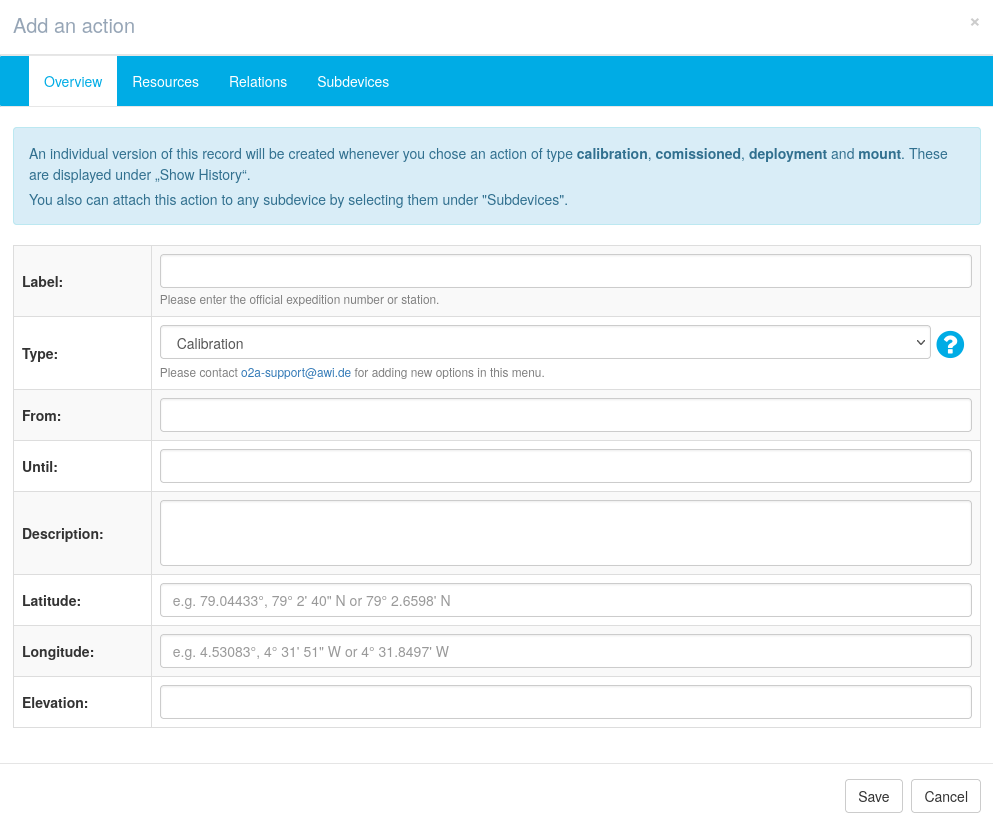Generally about Actions
In order to add certain ‘Actions’ to items, several ways are available:
- in case the item is located on one of the large or medium-sized german research vessels (Polarstern, Sonne, Meteor, Maria S. Merian, Alkor, Heincke, and Poseidon) you could use the autocompletion functionality (strongly recommended). Simply type the first three characters of the station label as listed in PANGAEA’s expedition catalogue (pangaea.de/expeditions/) to comfortably get the metadata fields under ‘Action’ filled out for you and this way avoiding possible typos,
- if the autocomplete feature does not apply to your items you could use registry.awi.de user interface to insert the mandatory information, or
- you could use the Rest-API (https://registry.awi.de/api) to insert the information by any programming language that is capable to sent HTTP requests.
The actions
- calibration
- comissioned
- deployment
- mount
automatically create a new version of the item (including a handle, such as this one: hdl.handle.net/10013/sensor.1b1ff06f-dc5c-4246-8844-f4bb305c9512) to have
- a reference for a specific setup, see ‘History and Citing’ at spaces.awi.de/x/zYa0FQ
- a stable representation in the Data Web Service (DWS, spaces.awi.de/x/aZgTF), because reassigning an item without a version of the former state makes its metadata volatile in DWS.
Since creating a new version can be omitted when reassigning an item, there is still the chance to do so (just for the case you recognized it was mistakenly without version) by manually create the mounting event and hence triggering the creation of a version.
‘Actions’ additionally give you as a user a chance to become more visible in DWS. Properly added missions make this data stream pop up there in the facet ‘Mission’. Furthermore entries of the types ‘Mission’ and ‘Deployment’ are searchable in DWS.
| Field in DWS to filter for Action Labels from registry.awi.de |
If the above mentioned facts were not convincing you to manage your metadata, the standardized entries from registry.awi.de/api can be forwarded to other places with ease, e.g. applications that make use of the API, such as Jupyter/R notebooks, knitr, webpages, portals or something alike.
Creating Actions
| Adding new Actions in registry.awi.de |
When adding new events some fields are mandatory and some are not. Nonetheless it is strongly recommended to fill in every field, since several services, such as autoQC (spaces.awi.de/x/22WjEw) make use of it. Furthermore, especially the spatial information can be used in map applications.
| Name | Description | Mandatory/Optional |
|---|---|---|
| Label | reasonable, coherent, and unique name of the event | Mandatory |
| Event Type | see table below | Mandatory |
| From | point in time when the event started | Mandatory |
| To | point in time when the event ended | Mandatory |
| Description | detailled description of the event, its circumstances, background, etc. | Optional |
| Latitude | aka N or S | Optional |
| Longitude | aka E or W | Optional |
| Elevation | applies to depth too, below water surfaces rather negative integers, else positive integers | Optional |
| systemName | id | description | uuid |
|---|---|---|---|
| Calibration | 15 | The item was recalibrated, the respective Calibration certificates and/or associated documents should be supplied via the Resources tab in the upper navigation banner. | c922c7f9-a2d8-464c-8f30-3ae60a30394a |
| Commissioned | 215 | This Event Type applies to large-scale platforms, such as land-based stations, research vessels, and aircrafts. It describes the beginning of the operational use of this device. | 3a791fbc-f2c8-4277-91e7-2c68e8c7dc55 |
| Configuration | 317 | Describes a change in an items configuration (something new has been mounted, the item has been recalibrated …) | 9fc7575c-6125-4dc6-89a7-eee2eb25755b |
| Decommissioned | 216 | This Event Type applies to large-scale platforms, such as land-based stations, research vessels, and aircrafts. It describes the end of the operational use of this device. | 94ae38e6-8fda-4c07-b40c-01833982812f |
| Deployment | 187 | A device is deployed, means it is in operational use. Deployment applies to small-scale vehicles and ship-operated devices, such as CTD rosettes, buoys, etc.. | 047a4f46-020b-4187-808a-6f245caebbc3 |
| Information | 50 | Describes issues associated with this item relevant for its operation. Includes failure and maintenance information. | d865bf37-04c3-44f5-a474-0458dc68f915 |
| Maintenance | 16 | The Event Type Maintenance describes functional checks, servicing, repairing or replacing of parts. The device might still be operational, but the device's measurements might be affected by means of maintenance. | d1a2a98a-8ad1-44a5-902f-9ce1513262cf |
| Mission | 182 | A Mission refers to the device's operation within a defined range of time and purpose. | 78318577-0e23-4dfe-ad2b-bfe6cb23b9a7 |
| Mount | 25 | The device installed/attached to a parental device. The Event Type Mount mostly applies to ship- and airborne sensors. | 13c8e2d6-a0ff-4612-bc7c-3d6540f52655 |
| Partial_failure | 200 | The Event Type Partial Failure should be set if the device's functionality somehow is restricted or limited. | f663f3a3-78bc-4c47-a9eb-f146571907e8 |
| Processing | 470 | Used in laboratory context, when samples run down a processing chain. | e45c70dc-5b6d-4ab9-a3eb-9d2c1597dad2 |
| Recovery | 188 | When a device is retrieved from water or ice the Event Type Recovery should be set. Then it is no longer operational. This usually applies to buoys or moorings. | 6fac6351-0c4a-48c1-87e4-a5e721f9c1ae |
| Total_failure | 201 | The Event Type Total Failure denominates the total loss of functionality of the respective device. Any re-use is foreclosed. | a6f292be-e5f6-4f4f-b34a-8e335675ed92 |
| Unmount | 26 | The device is extracted from a parental device. The Event Type Unmount mostly applies to ship- and airborne sensors. | 6f705b42-bc1f-4f47-89c8-7d89efabfdd5 |

